Canon EF 300 mm f/2.8 L IS II USM
3. Build quality and image stabilization
In the photo below we see three Canon lenses with the aperture of f/2.8 and focal lengths respectively 100, 200 and 300 mm. The increase of dimensions, when you progress from 200 to 300 mm is instantly noticeable.
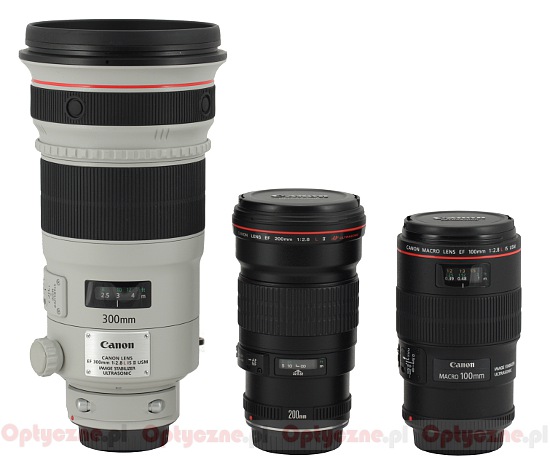 |
Please Support UsIf you enjoy our reviews and articles, and you want us to continue our work please, support our website by donating through PayPal. The funds are going to be used for paying our editorial team, renting servers, and equipping our testing studio; only that way we will be able to continue providing you interesting content for free. |
- - - - - - - - - - - - - - - - - - - - - - - - - - - - - - - - - - - - - - - - - - - - - - - -
The lens begins with a metal mount featuring contacts. When you glance inside the mount you can find the first optical element there, set about 17 mm deep inside, which is a removable filter with a diameter of 52 mm – added in the set. When you remove the filter the first proper element of the lens can be found at a depth of 3.5 centimeters. It is immobile and the area around it is black and well matted.
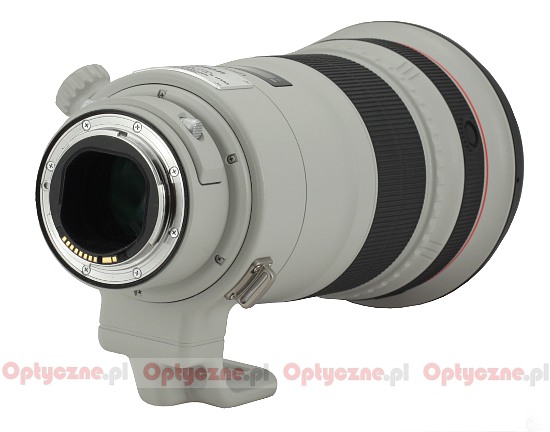 |
When you progress to the proper barrel you can see the first part of it which, when it comes to the dimensions, resembles the 1.4x Canon converter. At the top it has the filter thread, already mentioned above, 52 mm in diameter, and on the left – the focusing mechanism mode switch (AF- autofocus, PF – power focus, MF – manual focus) and also the focus limiter switch (with three ranges: FULL, from 2 to 6 meters and from 6 meters to infinity).
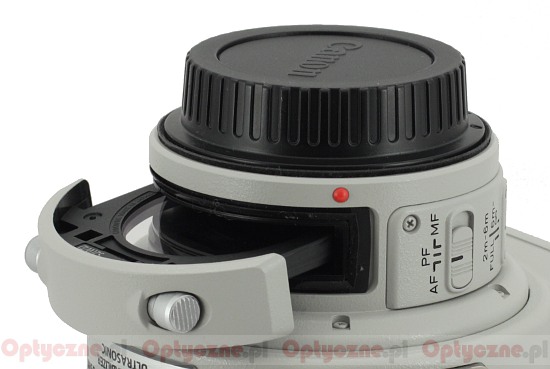 |
The next part of the casing is already much wider and it includes a very solid, huge ring which turns smoothly into an equally sold tripod mount. On the ring there is a plate with the name and the parameters of the lens, a loosening screw and metal grips to which a strap can be attached. Further on toward the front element we can find a distance scale behind a window, expressed in feet and meters. It doesn’t feature any depth of field scale. On the left side of the scale there is another series of switches. The first one allows you to chose an optical stabilization mode (1,2,3). According to the producer the third, additional mode is perfectly suited for action photography, especially using panoramic photography because it activates the image stabilization system only during the exposition. The next switch is used to turn the stabilization on and off (STABILIZER ON/OFF). Next we have a round SET button and below a FOCUS PRESET switch with three positions available (OFF, ON, sound signal). The FOCUS PRESET buttons are used to memorize the chosen position of the focusing mechanism and recall it at any given moment. This function works no matter what other mode - AF, MF or PF - is currently activated.
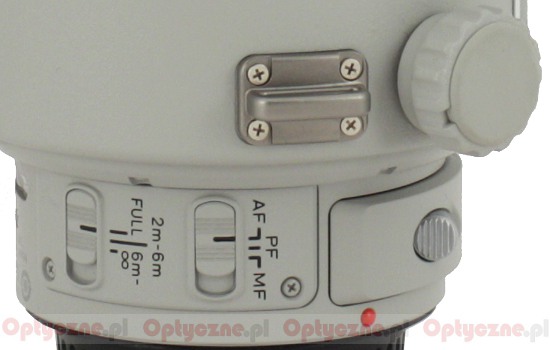 |
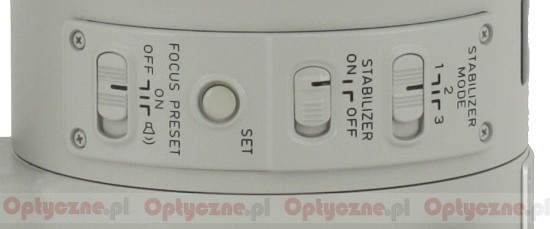 |
The next visible element is a big manual focus ring. It is as wide as 48 mm and covered by rubber ribs. Running through the whole distance scale needs a turn through 200 degrees. Right behind it there is a much narrower, white ring which is also ribbed but not covered by rubber (so-called Playback ring). It is used for manual focusing in the PF (power focus) mode, very useful e.g. during recording, ensuring you a smooth, delicate focus change. The next ring has rubberized ribs for a change but it is immobile, featuring four buttons, set 90 degrees apart, to block the autofocus position (so-called AF Stop Button). A red stripe, characteristic for the L series, and a hood mount are next elements of the casing.
At the front you can find a front element which is over 10 cm in diameter, immobile, and hidden about 2.5 cm deep inside the barrel.
When it comes to the optical construction we deal here with 16 elements positioned in 12 groups. The Canon company boasts of two low-dispersion fluorite glass elements and also special Subwavelength Coating (SWC). Inside there is also a circular aperture with nine diaphragm blades which can be closed down to the value of f/32.
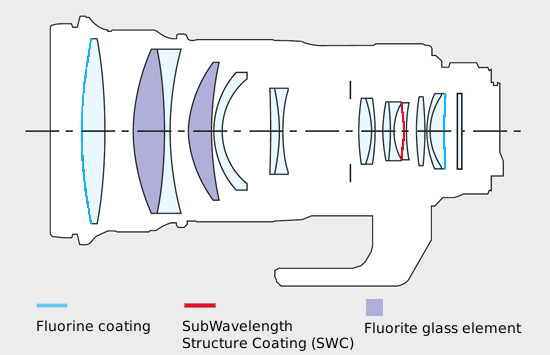
If you buy this lens, you will get a huge hood which, inverted and joined with a fabric ‘cap’, will serve as the front cap. Apart from that you have a tripod adapter and a high quality carrying case Canon 300B, dedicated specially for the lens.
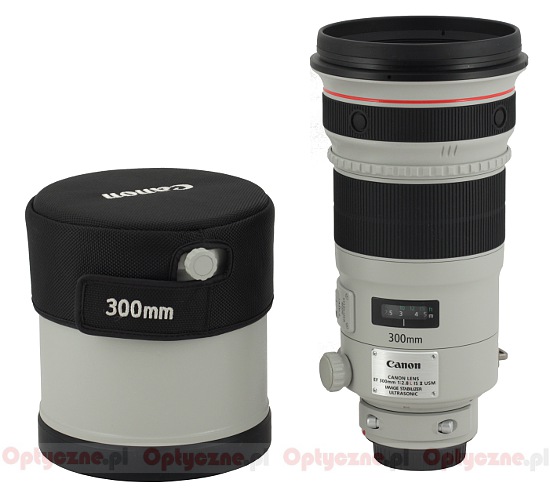 |
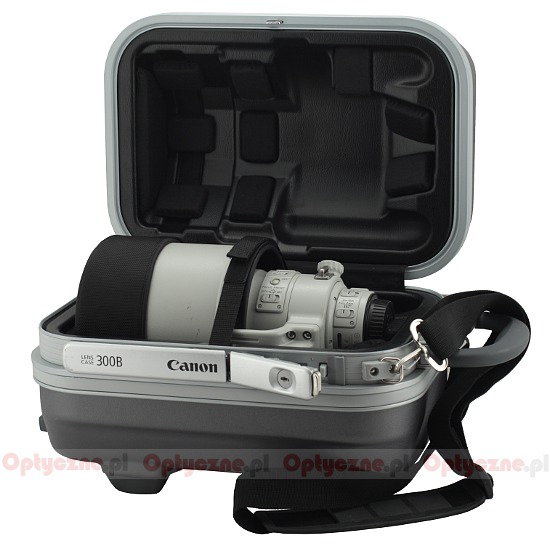 |
Stabilization
Currently almost every producer boasts of optical stabilization systems in their lenses as efficient as 4 EV. The problem is that such a good stabilization results are reserved only for the best and the most expensive devices on the market; in the case of most lenses the efficiency of that mechanism reaches 2-3 EV.
How the Canon EF 300 mm f/2.8L IS USM II fares you can find out looking at a graph, shown below.
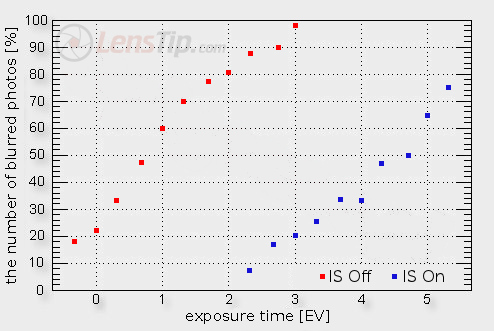
It shows the percentage of blurred photos as a function of the time of exposure, expressed in EV; 0 EV being the equivalent of 1/200 of a second. This percentage is calculated for photos taken with the stabilization switched on and switched off. The efficiency of stabilization we measure by determining the maximum distance between these two curves. In this case it amounts to almost exactly 4 EV so it works as efficiently as the manufacturer claims. It is really a very good result, fit for an expensive, professional lens.






